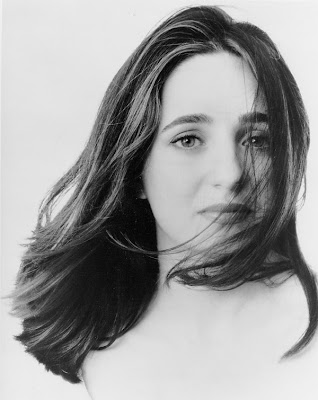
Pianist Simone Dinnerstein, photo courtesy of the Piatigorsky Foundation |
Media-blitzed pianist Simone Dinnerstein (pronounced "-steen") gave a sold-out recital at Baltimore's An die Musik LIVE! on Sunday afternoon. She played the Goldberg Variations, the piece she has recorded recently to such acclaim that it has become a best-seller, largely due to adoring reviews by Anne Midgette for the New York Times and Evan Eisenberg for Slate last month. Last week, Jens contributed a more balanced assessment of the CD for WETA's blog.
You may have thought that Ionarts had written enough about the Goldberg Variations after our double review of piano and harpsichord recordings, but there is always time to listen to another one. Dinnerstein's recording clocks in at around 78 minutes, a combination of taking all of the repeats and some unusual tempo choices, especially an extremely slow reading of the Aria. The tempo was perhaps a hair faster live, and Dinnerstein preserved her emphasis on the first beat of each measure, with a notably lesser dynamic on the second beat, almost like an echo effect. Although not identified as such, the Aria is most likely a sarabande, which justifies a dignified tempo. The accent in that dance, however, is on the second beat, which actually makes a lot of sense in terms of how the melody is constructed.
Dinnerstein's most noticeable strength is in the delineation of contrapuntal voices, especially in the inner parts, making her readings of the canons, which occur every third variation, exciting playing indeed. One is never without the sense of the canonic imitation of comes following dux as Dinnerstein plays these movements, something that can get lost in the virtuosic obsession of some musicians. Some of her more willful tempo choices, on the slow side, may have been due to this desire to sort out those knotted lines. The overly slow tempo chosen for Variation 15, marked only Andante but taken here as if it were a subdivided Largo, went far beyond this concern. Not that Dinnerstein cannot play fast, because she certainly can. Her Variation 17 was taken at a real clip, with a leggiero touch that made me hear the movement in a different way. The two killer movements, Variations 28 and 29, were both technically impressive, although at the expense of rhythmic cohesion, as the pulse was not constant between sections as rhythmic patterns changed.
Dinnerstein's live performance had many impressive moments and was a triumph of technical achievement, if not perfect (memory slips in Variations 9 and 22, from which she easily recovered and nailed on the repeats). This is all the more remarkable given the oppressive temperature in the snug performance space of An die Musik LIVE!, a renovated townhouse made into an eclectic and fun music store and venue. At the midpoint of the Goldbergs, after Variation 15 (and before the French ouverture of Variation 16 introduces the second half), Dinnerstein had to pause and ask the owner to turn the air conditioning back on. Its electronic vibration, noticeable to some in the room, was in conflict with the G major tonality of the variations. After this enjoyable recital, Dinnerstein mingled with the audience, signing autographs, while we sampled four Belgian-style beers offered by a sponsor, Cooperstown's Brewery Ommegang (their amber was particularly nice).
On a final note, another lack was the typical deficit of most pianists, ornamentation, which is another reason that I almost always prefer to listen to the work played by a Baroque-specializing harpsichordist (my current favorite is still Céline Frisch). Dinnerstein played a little fast and loose with the ornaments marked in the score and added only a few of her own, even on the repeats (although she always applied a different layering of voices on the repeat and her trills are to die for). A recent discovery is an intriguing piano recording of the Goldbergs by Chen Pi-hsien for Naxos, made in Frankfurt in 1985 (her Variation 15 is played as a real Andante). With this fast-paced recording (55:07, without many repeats), there are occasionally fun ornaments added, as there are in Murray Perahia's 2000 CD, still a favorite on the piano for me.
Simone Dinnerstein will perform again in the area next spring, playing the Beethoven cello sonatas with Zuill Bailey (her other recording, from 2006) at the National Gallery of Art on April 27.






















































1 comment:
I've just found Ionarts and even though I don't always know what you are talking about, you are a splendid writer and I'll learn the terminology to better follow the directly written presentations of the insights to sooner find my way into the music. A writer worth following. Well done. John in d.c.
Post a Comment